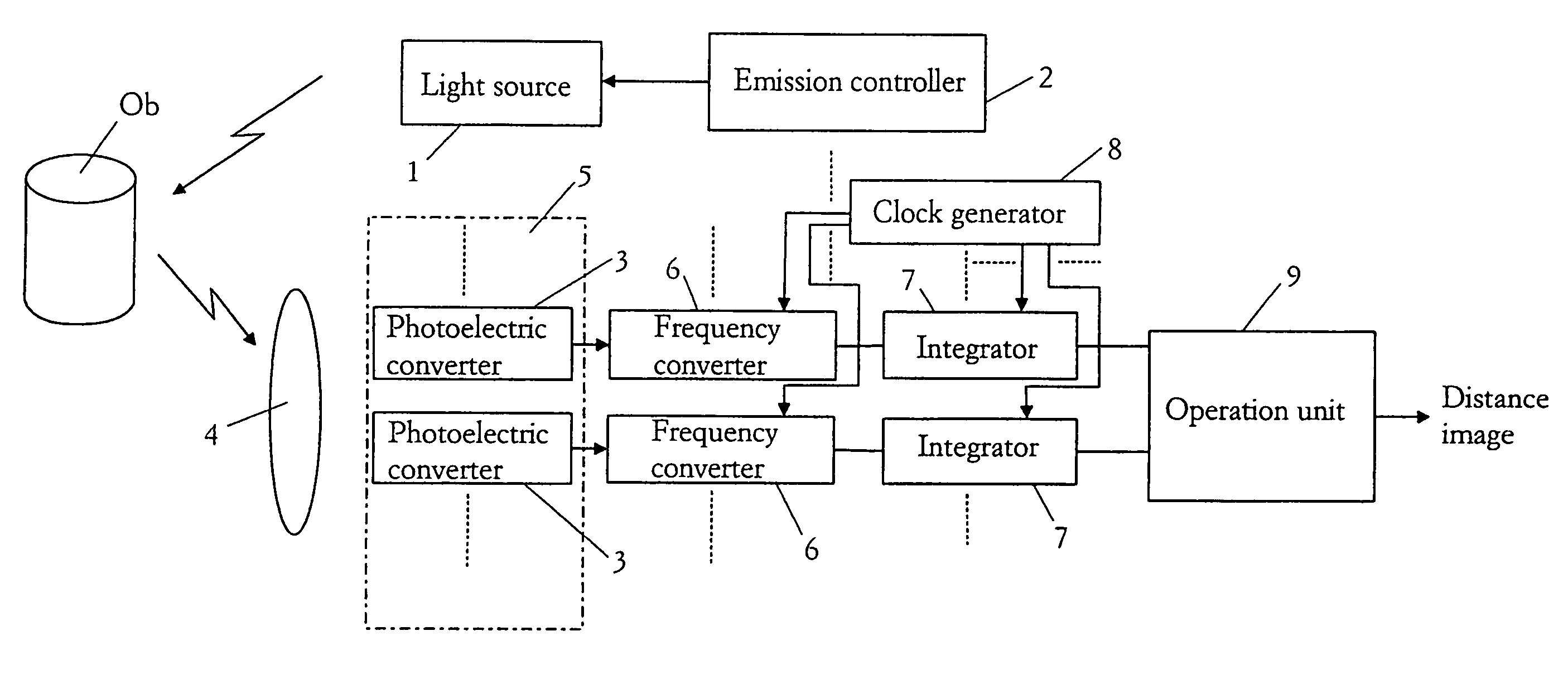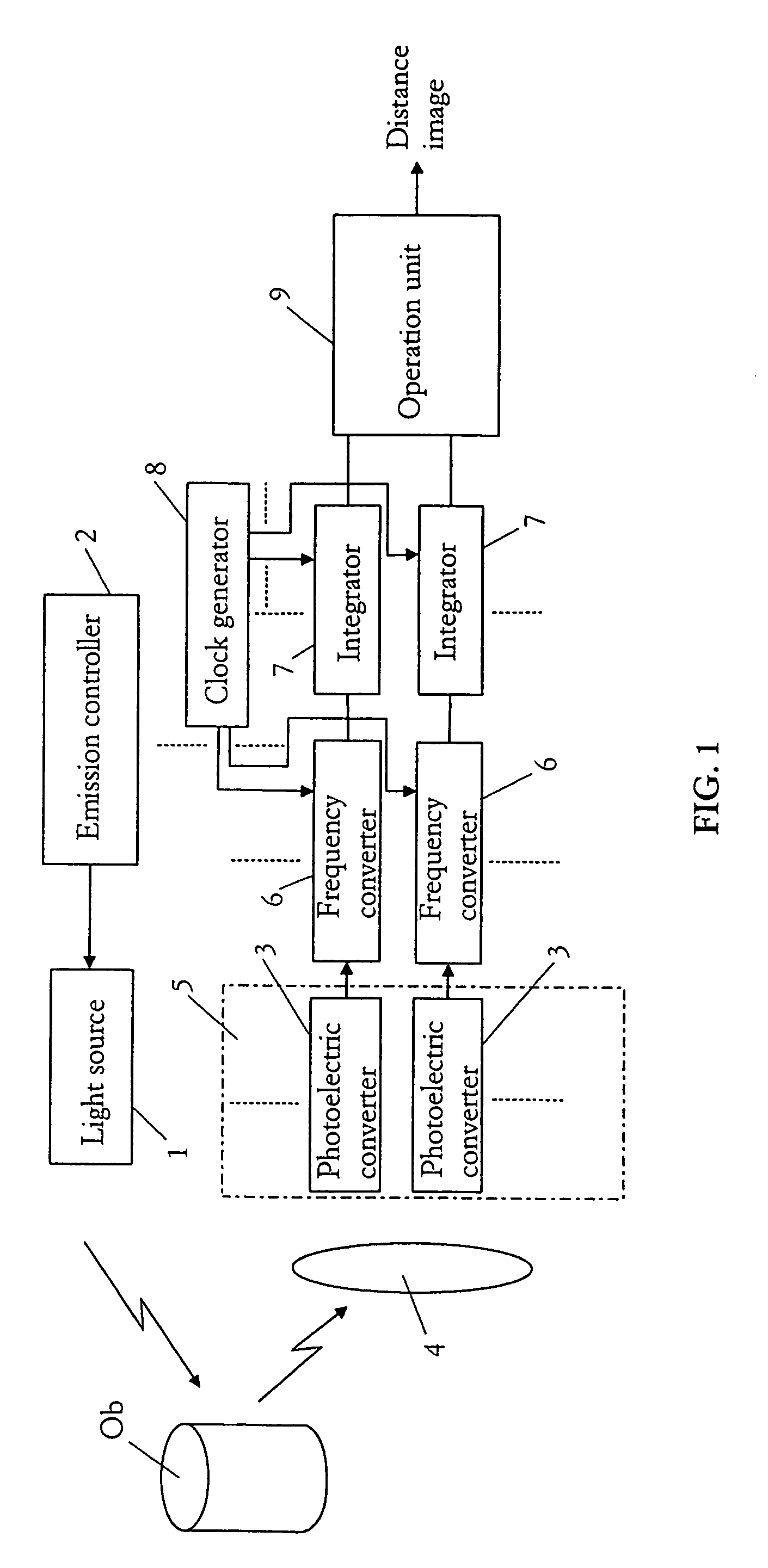Spatial information detecting device using intensity-modulated light and a beat signal
a technology of intensity-modulated light and detecting device, which is applied in the direction of radio frequency controlled devices, instruments, television systems, etc., can solve the problem of a relatively low degree of accuracy in time measurement, and achieve the effect of accurate detecting information and high-speed respons
- Summary
- Abstract
- Description
- Claims
- Application Information
AI Technical Summary
Benefits of technology
Problems solved by technology
Method used
Image
Examples
first embodiment
(First Embodiment)
[0061]As shown in FIG. 1, the distance measuring device of this embodiment has a light source 1 for emitting a light into a required space. The light emitted from the light source is intensity-modulated at a predetermined emission frequency by an emission controller 2. As the light source 1, for example, it is possible to use an array of light emitting diodes (LED) or a combination of a semiconductor laser and a divergent lens. As an example, the emission controller 2 intensity-modulates the light emitted from the light source 1 by a sine wave of 20 MHz.
[0062]In addition, the distance measuring device has a plurality of photoelectric converters 3 for receiving a light provided from the space through a lens 4. Each of the photoelectric converters 3 generates an electric output corresponding to an intensity of received light. In other words, the photoelectric converter 3 outputs a receiver signal with a signal level corresponding to the intensity of received light. F...
second embodiment
(Second Embodiment)
[0071]In the first embodiment, the photoelectric converters 3, frequency converters 6, and the integrators 7 are independent of one another. In this embodiment, they are integrally formed as an image sensor 5. That is, as shown in FIG. 3, the image sensor 5 comprises photoelectric converters 3 such as photodiodes, each of which generates, as the receiver signal, amounts of electric charges corresponding to the intensity of received light, memory cells 7a for storing the electric charges generated in the photoelectric converters 3, storage gates 6a, each of which adjusts the amounts of electric charges migrating from the photoelectric converter 3 to the corresponding memory cell 7a, and a transfer circuit 10 that functions as a charge ejector for ejecting the electric charges stored in each of the memory cells 7a to outside
[0072]The storage gate 6a is switched by the local oscillator signal output from a clock generator 8, so that amounts of signal charges correspo...
third embodiment
(Third Embodiment)
[0078]In this embodiment, an interline transfer CCD having a vertical-overflow drain is used as the image sensor 5. As this type of image sensor, it is possible to use one available in the market.
[0079]As shown in FIG. 5, the image sensor 5 is a 2-dimensional image sensor having a matrix arrangement of 3×4 photodiodes 21. The numeral 22 designates a vertical transfer portion composed of a vertical transfer CCD provided adjacent to the photodiodes 21 of each of the columns of the matrix arrangement. The numeral 23 designates a horizontal transfer portion composed of a horizontal transfer CCD provided under the vertical transfer portions. Each of the vertical transfer portions 22 has a pair of gate electrodes (22a, 22b) every photodiode 21. The horizontal transfer portion has a pair of gate electrodes (23a, 23b) every vertical transfer portion 22. The vertical transfer portion 22 is a 4-phase drive, and the horizontal transfer portion 23 is a 2-phase drive. Therefore...
PUM
| Property | Measurement | Unit |
|---|---|---|
| emission frequency | aaaaa | aaaaa |
| oscillator frequency | aaaaa | aaaaa |
| frequency | aaaaa | aaaaa |
Abstract
Description
Claims
Application Information
 Login to View More
Login to View More - R&D
- Intellectual Property
- Life Sciences
- Materials
- Tech Scout
- Unparalleled Data Quality
- Higher Quality Content
- 60% Fewer Hallucinations
Browse by: Latest US Patents, China's latest patents, Technical Efficacy Thesaurus, Application Domain, Technology Topic, Popular Technical Reports.
© 2025 PatSnap. All rights reserved.Legal|Privacy policy|Modern Slavery Act Transparency Statement|Sitemap|About US| Contact US: help@patsnap.com



